Device Profile: Sonos Digital Music System
Jan 6, 2005 — by LinuxDevices Staff — from the LinuxDevices Archive — 21 viewsA startup has created a unique Linux-based home music distribution system based on “secure peer-to-peer wireless mesh” networking technology. Sonos says its Digital Music System can route the same or different songs, sourced from any connected computer, to as many as 30 audio output devices simultaneously.
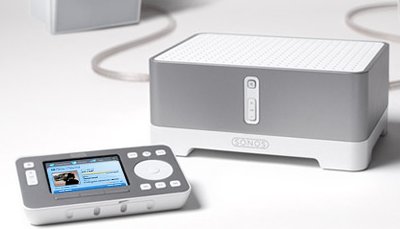
The Sonos System comprises a Controller and up to 32 ZonePlayers
The Controller
The Sonos System includes a handheld “Controller” system, based on a Hitachi SoC (system-on-chip) with an SH-4 processor core. The Controller connects wirelessly to the nearest of up to 32 ZonePlayers, from where it can control the entire Sonos System. Alternatively, the System can be controlled from a software application, available for Windows and Macintosh desktops.
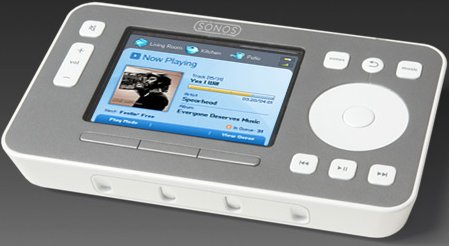
The Sonos Controller boasts a claimed battery life of five days
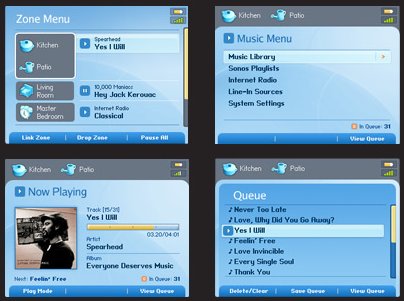
The Controller can control the entire Sonos System
The Controller and software also enable users to purchase, download, and play songs from the Real's Rhapsody music store.
The ZonePlayer
Each ZonePlayer is essentially an integrated 50-watt amplifier with a software-controlled pre-amp, and volume and mute switches on the front panel. Users supply their own speakers and, optionally, subwoofers.
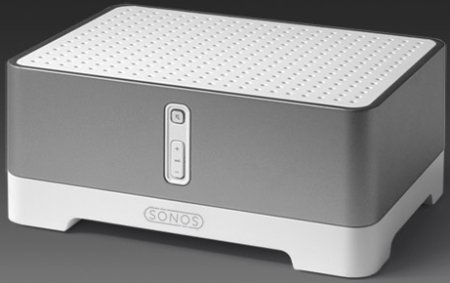
The ZonePlayer includes front-panel mute and volume controls
Each ZonePlayer also includes a solid-state (no fans or hard drive) Linux system running on a custom single-board computer (SBC), again based on an SH-4 processor, but with a TI DSP (digital signal processor) co-processor. The Linux system includes a media player and codecs for Windows Media, MP3, and raw WAV files. It also supports streaming MP3 files and comes pre-configured to access 70 Internet radio stations, with others easily added.
Ogg Vorbis is not supported in the initial firmware release, according to Sonos founder John MacFarlane (who previously founded software.com), but would be simple to add in subsequent revisions. He adds that the device is not intended for user modifications — the company has no plans to offer an SDK for it — but that “inevitably, users will hack it.”
Each ZonePlayer offers a four-port Ethernet switch, and can access media files stored on Macintosh or Windows shares, or on Linux-based NAS volumes supporting CIFS. Media files on connected devices can be decoded and routed for output on any or all ZonePlayers. ZonePlayers also include audio I/O ports, and sound from attached stereo components can be routed singly, in groups, or to all ZonePlayers.
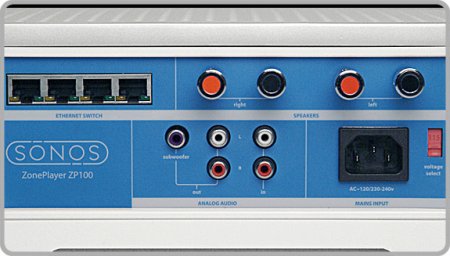
Each ZonePlayer includes a four-port Ethernet switch, speaker posts, and analog audio in/out connections
Sonosnet
ZonePlayers can communicate with one another over standard Ethernet networks, and are ideal for installation in homes that are wired for Ethernet, Sonos says. Where Ethernet is not available, Sonos components within range of each other automatically form a self-configuring network based on “Sonosnet,” the company's custom-built, secure, peer-to-peer wireless mesh networking technology.
According to MacFarlane, Sonosnet supports features required by the project, but unavailable in other protocols when the project started. One such feature is aggressive, asynchronous power management — the ZonePlayers serve as access points for the Controller, which boasts an impressive battery life of five days under normal use.
Another Sonos System feature uniquely supported by Sonosnet is the claimed ability to route an audio signal to multiple ZonePlayers without echo or loss of synchronization, an inherent challenge under a “best-effort” protocol such as IP. MacFarlane says strict synchronization is fairly easy on the simple wired networks typical of home installations, where ping times are consistent and predictable, but becomes harder in a wireless setting. “We started out [using some open source multicast technologies], but sadly had to back them out because they weren't well supported by NICs and other computer components,” MacFarlane said.
MacFarlane adds that Sonos worked two years to develop and test Sonosnet, and may consider commercial or open source licenses for the technology in the future. “As you know, in complex partial mesh networks, you can't have routing loops. Grouping together different zones of music [was a] considerable amount of effort.”
Another interesting feature of Sonosnet is the capability of bridging with Ethernet networks, enabling two computers connected to ZonePlayers to share files wirelessly over Sonosnet — without affecting the quality of music playback, MacFarlane claims.
Linux implementation
The Sonos Controller and ZonePlayers are powered by a Linux implementation that Sonos developed in-house. The implementation is based on a 2.4 kernel, with backporting of threading and other features from 2.6, according to MacFarlane. “We have a great team of ex-Microsoft people who are real comfortable with kernel-level work,” MacFarlane says, adding that some of Sonos's Microsoft expats worked on the FrontPage team. The team is working on a 2.6 kernel implementation, but felt the new kernel was not yet stable enough for the initial production release, MacFarlane adds.
Besides Linux, a variety of open source projects were leveraged in the project, including IBM's SysFS file system, MacFarlane says.
Sonos
MacFarlane describes Sonos as a group of people that always wanted to work together, and finally had the chance. The privately funded company has “northwards of 50” employees, including “an audio engineer who was a Kurzweil engineer who helped make the first electric piano,” and hardware engineers from a hardware video background.
Availability
Sonos expects to ship production versions of the Sonos System by the end of January, but is still working out the details of its sales and distribution channel. The Sonos website offers a notification form for product availability. The Controller will be priced initially at $399, and each ZonePlayer will cost $499. A starter package with a Controller and two ZonePlayers will be offered initially, priced at $1,199.
Sonos is showing off its system at the Consumer Electronics Show in Las Vegas this week, where the Sonos System won the “Best of Audio” award in the Consumer Electronics Association's 2005 CES Innovations Design and Engineering Awards competition.
This article was originally published on LinuxDevices.com and has been donated to the open source community by QuinStreet Inc. Please visit LinuxToday.com for up-to-date news and articles about Linux and open source.